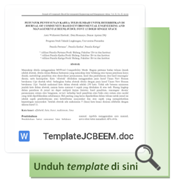Spatial-Temporal Land Use Change in Depati Amir Airport Based on Google Earth Imagery
DOI:
https://doi.org/10.23969/jcbeem.v7i2.7905Keywords:
spatial-temporal, land use change, airport area, Google Earth imageryAbstract
The new Depati Amir Airport was built in 2013, which can destroy the natural vegetation due to the airport's development and extensive buildings. The research aims to identify and analyze the spatial‐temporal land‐use change characteristics in the new Depati Amir Airport. The land use change detections are in the new Depati Amir Airport by spatial-temporal analysis with three land use maps (2004, 2014, and 2022) on Google Earth Imagery. Google Earth Imagery is analyzed with QGIS to assess spatiotemporal land use changes in the new Depati Amir Airport between 2004, 2014, and 2022. Depati Amir Airport, as the new airport in Bangka Tengah Regency, has influenced land use change in Bangka Tengah Regency. The new Depati Amir Airport land types are buildings, including roads, natural vegetation, tin mining, and open space. The three new Depati Amir Airport Imagery in 2004, 2014, and 2022 on Google Earth Data can examine land use changes that depict red, orange, purple, and green rectangles. The natural vegetation and tin mining decreased due to the development of a new airport, such as roads, open spaces, and extensive buildings with a significant transformation. Hence, understanding the land use changes for local governments, regional planners, and scientific communities require close attention to spatial to reach crucial knowledge.
Downloads
References
Abdelaty, E. F. S. (2016). Land use change detection and prediction using high spatial resolution Google Earth imagery and GIS techniques: a study on El-Beheira Governorate, Egypt. Fourth International Conference on Remote Sensing and Geoinformation of the Environment (RSCy2016), 9688(December), 968803. https://doi.org/10.1117/12.2239898
Ge, Y., Hu, S., Ren, Z., Jia, Y., Wang, J., Liu, M., Zhang, D., Zhao, W., Luo, Y., Fu, Y., Bai, H., & Chen, Y. (2019). Mapping annual land use changes in China’s poverty-stricken areas from 2013 to 2018. Remote Sensing of Environment, 232. https://doi.org/10.1016/j.rse.2019.111285
Kasim, O. F., Wahab, B., & Oweniwe, M. F. (2022). Urban expansion and enhanced flood risk in Africa: The example of Lagos. Environmental Hazards, 21(2), 137–158. https://doi.org/10.1080/17477891.2021.1932404
Koroso, N. H., Lengoiboni, M., & Zevenbergen, J. A. (2021). Urbanization and urban land use efficiency: Evidence from regional and Addis Ababa satellite cities, Ethiopia. Habitat International, 117. https://doi.org/10.1016/j.habitatint.2021.102437
Li, H., Xiao, P., Feng, X., Yang, Y., Wang, L., Zhang, W., Wang, X., Feng, W., & Chang, X. (2017). Using Land Long-Term Data Records to Map Land Cover Changes in China over 1981-2010. IEEE Journal of Selected Topics in Applied Earth Observations and Remote Sensing, 10(4), 1372–1389. https://doi.org/10.1109/JSTARS.2016.2645203
Malarvizhi, K., Kumar, S. V., & Porchelvan, P. (2016). Use of High Resolution Google Earth Satellite Imagery in Landuse Map Preparation for Urban Related Applications. Procedia Technology, 24, 1835–1842. https://doi.org/10.1016/j.protcy.2016.05.231
Putri, A. W., Afifah, S., & Renika, J. (2021). Pendekatan ACIM (Action, Communication, And Islamic Moral) dalam Pembelajaran Pencemaran Lingkungan. Jurnal Pendidikan Indonesia, Vol. 2 No. 03 (2021): Jurnal Pendidikan Indonesia (Japendi), 533–542. https://japendi.publikasiindonesia.id/index.php/japendi/article/view/121/880
Shih, H.-C., Stow, D. A., Weeks, J. R., & Coulter, L. L. (2016). Determining the Type and Starting Time of Land Cover and Land Use Change in Southern Ghana Based on Discrete Analysis of Dense Landsat Image Time Series. IEEE Journal of Selected Topics in Applied Earth Observations and Remote Sensing, 9(5), 2064–2073. https://doi.org/10.1109/JSTARS.2015.2504371
Wibowo, A., Salleh, K. O., Frans, F. T. R. S., & Semedi, J. M. (2016). Spatial Temporal Land Use Change Detection Using Google Earth Data. IOP Conference Series: Earth and Environmental Science, 47(1). https://doi.org/10.1088/1755-1315/47/1/012031
Zhang, L., Jin, G., Wan, Q., Liu, Y., & Wei, X. (2018). Measurement of ecological land use/cover change and its varying spatiotemporal driving forces by statistical and survival analysis: A case study of Yingkou City, China. Sustainability (Switzerland), 10(12). https://doi.org/10.3390/su10124567
Zhao, Y., An, R., Xiong, N., Ou, D., & Jiang, C. (2021). Spatio temporal land use/land cover change dynamics in coastal plains in hangzhou bay area, china from 2009 to 2020 using google earth engine. Land, 10(11). https://doi.org/10.3390/land10111149














